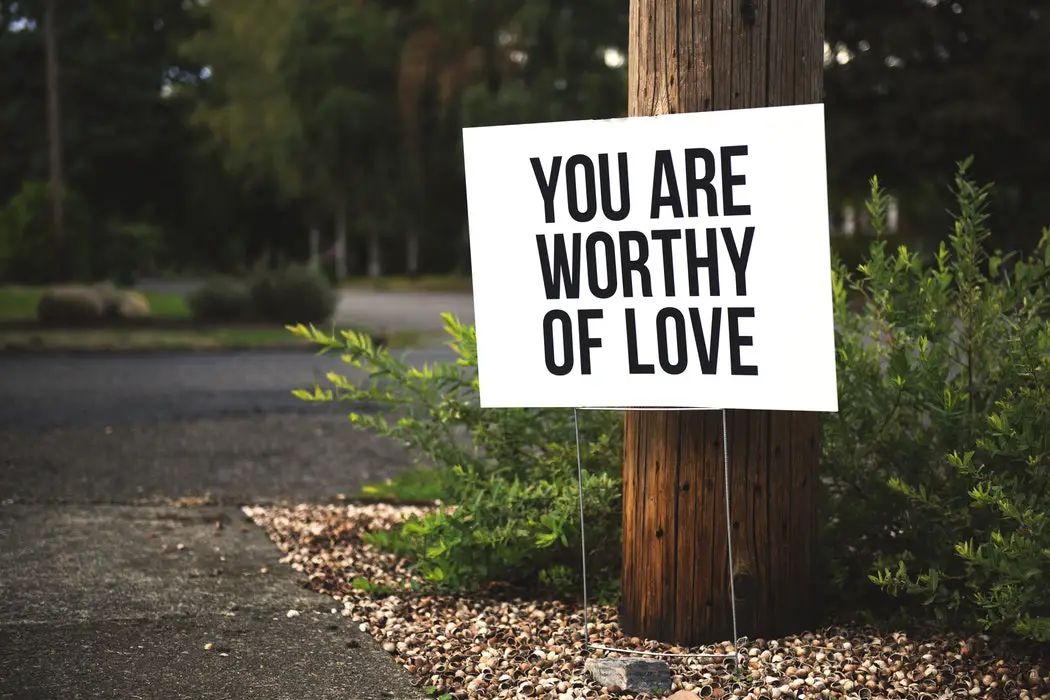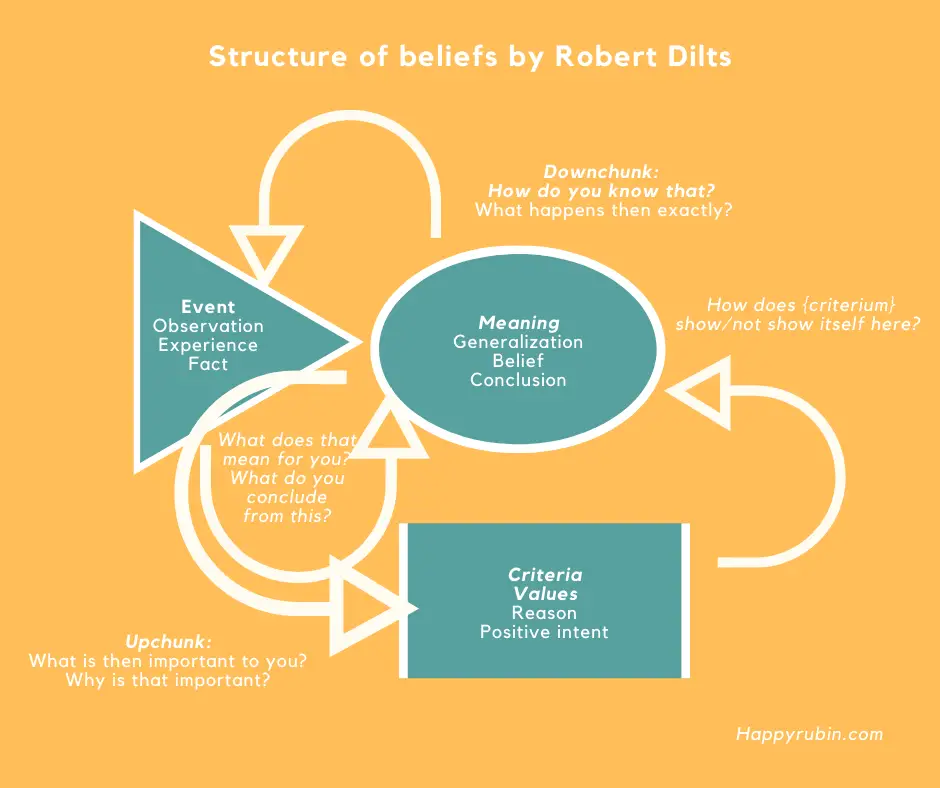![How To Deal With Sensory Overload [9 Tips For Overstimulation]](https://happyrubin.com/wp-content/uploads/2019/12/ik-ben-overprikkeld-150x150.jpg)
How To Turn Limiting Beliefs Into Empowering Ones [Full Guide]
![How To Turn Limiting Beliefs Into Empowering Ones [Full Guide]](https://happyrubin.com/wp-content/uploads/2015/11/belemmerende-overtuigingen.jpeg)
How can you turn limiting beliefs into empowering beliefs? And what are (limiting) beliefs actually? In this article you will find a clear explanation. Read along and find out all about beliefs…
Sources used: my teachers from Vidarte
Contents of this page:
What are beliefs?
Beliefs are one of the filters through which we experience the world. To be more precise, beliefs are generalizations that often arise from the past. You have been through something one or more times, and then you believe it always will be.
Beliefs determine what we perceive as possible and impossible and we trust that they are true. However, are they the truth? They are ‘just’ beliefs and not absolutely true and set in stone. Moreover, every moment is new and we are new every moment. Beliefs are maintained but the past does not equal the future …
Beliefs are not the truth. They are just beliefs.
In addition, you can make a division: we know promoting beliefs and limiting beliefs.
Beliefs are generalizations, but about what?

Robert Dilts does a lot of work in the field of beliefs. He explains beliefs as limiting or empowering generalizations .
Beliefs are meaningful and empowering when you use them subjectively in certain contexts . For every belief, a context can be found in which it makes sense to apply that belief.
Beliefs become limiting when you start to view them as objective. If you apply a belief to multiple contexts – so generalize – you will eventually encounter a situation in which that belief has a limiting effect.
The well-known example is that of the child learning from his / her parents not to talk to strangers. If that belief is generalized to more contexts, for example to later in the adult life of the child – this belief has a limiting effect.
Another example: The belief “The more I give, the happier I will be,” doesn’t make sense if you live in a family where you are not appreciated when you do something for others. In your current family context, it makes sense to stop applying that belief (and perhaps divorce). In other contexts, such as your new relationship or your volunteer work, it does make sense to apply that belief.
Beliefs are (unconscious) generalizations about …
- causes;
- intentions;
- meanings;
- boundaries;
- and limitations.
… concerning:
- the world around us;
- specific behavior;
- capabilities;
- values;
- identity;
- and meaning.
Do you see that there can be different types of beliefs? Namely …
- at the superficial level: environment, skills and behavior;
- and at core level: values, identity and meaning.
Examples of (limiting, negative) beliefs
Examples of limiting beliefs are:
- I can’t follow my dreams because I might fail.
- I don’t look pretty, I can’t present to groups.
- What I have to say is not important.
- It’s too late … There’s nothing I can do anyway …
- I am a victim.
I decided I could do anything.
– Loesje
How do you spot other examples of beliefs? Later in this article you will learn exactly how to recognize and track beliefs. First we need to discuss why beliefs are so important …
If you say to yourself, “It’s hard to get up in the morning” or, “It’s hard to quit smoking,” then you are engaging in self-hypnosis.
– Richard Bandler
Beliefs influence skills, behavior and environment – That’s why they are so important

If you are really convinced that you are not a nice person, then that is the reality for you. Even if 100 people say that you are a nice person, you will not realize that. You don’t even hear it. Or if you are really convinced that you are a nice person, then that is your reality and you will not hurt (it does not get through) if 100 people say that you are not a nice person. So your beliefs guide your selective perception.
If we hold tight to our beliefs, we risk becoming blind to reality and seeing only what our beliefs confirm.
– Haemin Sunim
This is also called ‘confirmation bias’: you look for what supports your belief (deduction). If you believe you were born for happiness, you see it everywhere. If you were born before the accident, you see that everywhere. Beliefs influence the lower logical levels in countless other ways as well .
Everyone has their own beliefs, and they are not the truth.
Beliefs are powerful. In this article about raising children positively you will find the well – known Rosenthal effect. These experiments taught us that when you tell a class and to the parents in a primary school that they are all VWO students, many more students will pass VWO, and if you say correctly that they are VMBO students, many more get the VMBO.
Whether you think you can or think you can’t. Either way, you will be right.
– Henry FordBelieve you can. With that, half has already been overcome.
– Theodore Roosevelt
Now that we know this about beliefs, we can already draw a conclusion …
One conclusion that we can already draw is that if you want to change or improve your behavior, for example , it can be useful to investigate what beliefs you have about this. Your beliefs determine how you filter: they determine your omissions, distortions and generalizations.
I never listen to someone explain why you can’t do something.
– Michael Caine
Many beliefs originated when you were 0-7 years old (the imprint period)

NLP trainer Sylvia de Vries once sketched the iconic example of a kindergarten class: if a child in kindergarten is allowed to choose colors to start drawing, and it takes a little long, what does it do to the child when the master says: ‘Here! You cannot make choices. Take this one! ‘ And a belief has just emerged …
A teacher only has to say to the class while singing: ‘You can pick up a tambourine and hit it twice a minute. If you stand in the back, we can hear the children who can sing well better. ‘
– Saskia Jansen
If you ask a group of children during the imprint period, “Who is really good at singing / drawing?” Then everyone shouts enthusiastically: “I, I, I!” If you ask this question to a group of adults, maybe a hand will rise …
Our thoughts are our only limit.
How do you elicit/spot beliefs?
The techniques below and the techniques that are listed later in this article often originate from Robert Dilts’ book: ‘Change your Beliefs’ (via Bol.com). This book is recommended as optional and often even mandatory literature for NLP courses. Highly recommended if you want to know everything about beliefs!
Do you want to detect beliefs in yourself or in someone else? Then focus on the following:
- A constantly repeating behavior ( pattern ) that is an example of the belief.
- Inconsistencies, which can manifest themselves, for example, through doubts / hiccups in your behavior.
- Something that the other wants, but does not do. Something that always fails.
- A hesitation while answering the question. Even when the other person needs thinking time or shows resistance, you know that you are on the right track in detecting a belief.
- Watch for statements that make someone devalue themselves: “This doesn’t look like anything, but …”
- A kind of invisible blockage. ‘I don’t know what’s holding me back …’
- An identification: “I am a {nice, boring, repulsive} person.”
- Also values say something about beliefs.
- Ask the question, “How would you behave if you had {desired outcome} now? Can you pretend? Why not?’ Pay attention to limiting beliefs and decisions!
- Ask the following questions to identify limiting beliefs:
– How do you think you have unrealistic expectations about yourself? (Make a list)
– How are you too hard on yourself? (Make a list)
– What should you always do? (Make a list: “I always have to …” and “I never have to …”
– What do you want? What’s stopping you from getting it? What’s holding you back? How (s) do you hold yourself back?
– If you have it, what would scare you to have it?
– What are you avoiding?
– What feeling are you avoiding so you don’t have to feel it? How does this avoidance behavior affect your life? ?
– What would be the worst insult anyone could throw at you?
– If I really wanted to hurt your feelings, what would I say?
– What makes you feel ashamed to look at it that stops you from doing…?
– What rules do you have about how you should behave that are blocking yourself from moving forward?
– What do you believe in that limits you from being completely yourself?
Study especially the Milton Model and pay attention to modal operators of impossibility and necessity, complex equivalence, cause-effect, (implicit) universal quantifiers and presuppositions in the language of the other person .
- Cause-effect, ” If I do as I’m told, then I’ll receive love.”
- Complex Equivalence: “All men are liars.”
- Complex equivalence regarding someone’s identity: “I am worthless. I am a bad salesman.”
- Presupposition: things we assume to be true without explicitly mentioning them. The deeper the presupposition, the more unconscious the belief is. “At what time does the sun rise today?” The premise, or belief, “The sun rises.”
- Universal Quantifier: ” Nobody likes me.”
- Modal operator of necessity: “We have to use sunscreen today.”
Do you recognize the above patterns in the examples of beliefs below?
- Relationships should be easy or they aren’t worth it.
- I am not smart enough to learn this material.
- Whatever I do, it won’t make a difference anyway.
- If I do as I’m told, I will receive love.
- The more I give, the more success I will be.
- If I give myself to others, it will definitely reciprocate (Hear the implicit universal quantifier?)
- All Swedish women are beautiful.
- All men are liars.
- I am unworthy.
- I am a victim.
- There is always a way.
- Great material happiness is great slavery.
The structure of the belief
You can use the above model to map out the structure of a belief. For that you can simply ask the questions in the model. At the oval are the beliefs, meaning meaning, or the conclusion / generalization. Such a belief is based on one or more experiences – the triangle. Criteria – the square – also play a role.
For example, if someone is convinced that “Moroccans cannot be trusted,” you can start by asking about the phenomenon: How do you know? What exactly happens then? And from there you can follow the arrows and ask the other questions.
Does the word ‘meaning’ in the oval sound familiar to you? You may recognize it from the meta-model : a complex equivalence. A means B. {Phenomenon} means {Belief}.
- Failure means I am a failure and never will succeed.
- If my boss locks himself in his office, it means he doesn’t appreciate my input.
- If I don’t make a lot of money, it means I’m lazy.
- If customers don’t buy, it means something must be wrong with the product.
- If I feel bad when I exercise for a while, it means that exercise is bad for me.
There may also be a cause-and-effect construction. A causes B. If {phenomenon}, then {conviction}.
- Successful events make people arrogant.
- When my boss locks himself in his office, I get very annoyed.
- If I don’t have a lot of money I can’t have fun.
- My students don’t do their homework because they spend too much time partying.
How do you change limiting beliefs?
Beliefs can be changed in two ways: simply in a conversation or in a formal exercise . Let’s start with how to change beliefs in ordinary conversation . Below you will find a number of examples of these re-thinking reframes:
Way 1: from the oval to the square in the above model
We will make use of chunking: becoming more abstract and / or more concrete. First you will upchun to find the positive intention, or the criteria of the belief (for example, certainty). Then you can downchun into an alternative belief system for fulfilling that same positive intention.
So:
- First upchunken: “What is the positive intention of this belief? What does this feeling want to protect you from? What does it want to tell you? What does this belief do for you? How does it serve you? Isn’t it more important that …?”
- Then you chunk down again to a new belief: “How can you satisfy the positive intention in a different way, without needing this belief?”
Way 2: from the oval to the triangle in the above model
“Is that correct?” Chunk down to phenomena, or facts, so that you come across counterexamples for the belief in question. For example, “You see, men also do A, B, and C, which shows that not all men are pigs.” “Oh, I hadn’t noticed those examples yet. That makes me question my belief!”
Use more metamodel questions to disprove the belief by showing the other person that the belief is limiting: “Who says that? According to whom? How do you know that’s true? What concrete evidence do you have to back up this belief? Do you have examples where it did? “
Way 3: more re-framing possibilities (reframing)
You can use the article on reframing to reframe the phenomenon, meaning or criteria – these are the three elements from the model of the previous section.
Take the ‘world model reframing’, for example. This reframing is at the downchunk level, so in the triangle of the above model: the phenomenon. The world model reframing shows beautifully that a belief is not a fact and that it could be completely different tomorrow. Below are some examples of this reframing:
- “Life is hard.” “So for you , Piet, has your experience been that life had been difficult?”
- “I can not sing.” “So your perception is that you can’t sing?”
- “It’s hard to make money.” “So it’s hard for you to make money?”
- “I find it difficult to get up early.” “So at some point in your life you had the experience that it is difficult to get up early.”
- “The world is flat.” So you believe the world is flat. So your perception is that the world is flat. “
- “I can’t learn.” “So you’ve had experiences from which you concluded you can’t learn.”
- “I can’t get to my gut.” ‘No, that’s not true – it’s not a fact – you can get to your feelings. Because with ‘I can’t feel’ you pin it as if you always are, while you are completely new tomorrow or even the next minute.
Or take the meaning reframing: this is the reframing of the oval in the model above: “What other meaning can we give to the phenomenon?”
Here you will find all reframing categories.
Your limiting beliefs are not true. “I can’t get to my gut.” “I can not do it.” “It’s not in my blood …” Stop believing your thoughts. You make them up. They are not true. They are not who you are, although they do sound like you. If you weren’t having those depressed, negative, anxious, scarcity thoughts, who would you be? Completely fine.
More ways to change beliefs

Beliefs turn into a regular conversation
- Getting information. However you see the relationships between the triangle, the oval and the square, it is very useful to ask them all. For example, have you only heard the oval? “I feel irritated,” then you can ask, “What’s that causing you?”
- How does this affect your life? How has this belief / lack of belief in yourself cost you dear?
- What will happen if you keep believing this (in a year)?
- Is that you or is that your gremlin talking?
- Who would you be without that thought?
- Where did this belief come from? Who gave you this belief? How do you feel about this person now? Do you respect him? Is this belief still valid today? Does it make sense to still believe him?
- Use all other questions of the coach model, of which limiting beliefs are a part, namely with ‘obstacles.’
- Do not believe everything you think. Do you think no one liked you in your high school days, or that others thought you were weird? You do it all to yourself. In reality, it could just be that everyone found you to be very relaxed and confident …
- “I just can’t seem to feel happy.” “When did you decide that?”
- Was there a point in your life when someone told you it’s not okay to …?
- Use the miracle question: Pretend you believe {new belief} now.
- Use priming to cast doubt on a belief. As you will learn later in this article with the horseshoe model, it makes sense not to go directly from believing to not believing anymore , but to go from believing via doubting to not believing anymore .
Any “I can’t do it” is actually “I haven’t done it yet.” And that even becomes: “I’m going to do it.”
Belief-changing with a formal technique
You can also use formal techniques . Many NLP techniques effect a change in a person’s beliefs.
- The most obvious technique is mapping across.
- In addition, behavior / action is important for installing a new belief, because behavior is the expression of a belief. Use a “what if” frame for this : How would you behave if you had {new empowering belief x}? List these behaviors and baby steps that you otherwise wouldn’t have come up with and write them down. The conviction will then be installed if you are also going to perform the actions in the coming days.
- Making the logical levels congruent also solves this.
- In addition, you can use the 6-step reassessment to satisfy the positive intention of the belief in a different way.
- You can also use Change personal history / reimprinting to go to the origin of the belief in this way and to use new resources (states of mind) to undo the belief.
- Time Line Therapy contains a special technique for limiting decisions.
- The integration of parts is very suitable for when a conviction is sometimes effective and sometimes not.
- A change of behavior can lead to a change of beliefs. That is why the behavior generator can also work.
- Even techniques such as the meta model serve this. This invalidates the belief.
- You can also use visualization to install new beliefs. Be creative about this. For example … Close your eyes. Be quiet. Take a deep breath. Imagine a beautiful radiant light in your mind and heart so that there are no dark corners left. Imagine that the screen of your mind has been completely wiped clean so that you can put another belief – another movie – into it. Now you can play a love story, a success story or a happiness story. Choose your belief, let the movie start and live your life.
- You can also address limiting beliefs with Byron Katie’s four questions.
- The more you talk about something to other people, the more you start to believe it. You don’t even need other people: through affirmations you can often express your new beliefs so that they always become real.
- In the next section you will find a unique model for changing beliefs: the horseshoe model.
Any belief you choose becomes true. Do you want to be right to have your old beliefs confirmed, or do you want to be happy by being open to new positive beliefs?
General steps for changing beliefs in both regular conversation and formal technique
- Collect information.
- Loosen the old belief a little.
- Replace the old belief with a new belief.
- Test
- Future pace
- Install the new belief on your timeline in a context where / when it makes sense.
Actually, I can.
Don’t put too much emphasis on limiting beliefs: no one is broken

You don’t even need to know or name your limiting beliefs. There is nothing wrong with you. It is not at all that you “sabotage yourself with limiting beliefs.” Never go there with your thoughts.
You just have to install the beliefs you want. So what you can do: ‘How else can I watch this? What am I not seeing now that I might be able to see? What new door can I knock on? What other aspect is this? What new twist can I give this? ‘
Closing thought: beliefs are important, but don’t be blind to them …
If you put too much emphasis on beliefs, you run the risk of becoming a woolly guru. Sometimes you just have to be much more concrete than working with beliefs, which is an abstract concept.
How do you work more specifically? By also looking a logical level lower , so that you arrive at capacity level.
Suppose a pilot is convinced that he / she cannot fly properly. If the pilot ‘s capabilities are actually lacking to fly, then we should all be happy that the pilot believes he / she cannot fly properly. The pilot does not have to work exclusively on his / her beliefs at all, but also on his / her flying skills. That will save many lives …
For the pilot, beliefs can also be empowering and motivating by feeling: “This is what I want!” Beliefs like “I am a procrastinator” or “I am not worthy to learn this” can also be addressed.
But you should certainly not treat “I am not good at flying” in this example at a conviction level, but at a capacity level.
In short: make a good distinction between beliefs and other logical levels.
Do you want to delve further into beliefs? Then ‘Change your Beliefs’ by Robert Dilts is mandatory.

![5 Best Self Care Tips For College Students [#1 Advice]](https://happyrubin.com/wp-content/uploads/2021/09/the-best-self-care-tips-for-college-students-440x264.jpg)
![How To Stick To New Year’s Resolutions: 9 Tips [Smart & Sure Ways]](https://happyrubin.com/wp-content/uploads/2019/12/tips-voor-goede-voornemens-440x264.jpg)
![How To Stop Being So Hard On Yourself [9 Great Tips]](https://happyrubin.com/wp-content/uploads/2019/12/we-moeten-zoveel-van-onszelf-en-anderen-150x150.jpg)

![19 Best Ice Breaker & Get-To-Know-Eachother Games [Fun & Simple]](https://happyrubin.com/wp-content/uploads/2018/02/leukste-ijsbrekers.jpeg)
![Becoming More Social: 41 Tips [Improving Social Skills] [List]](https://happyrubin.com/wp-content/uploads/2018/06/sociale-vaardigheden1.jpeg)
![How to start a conversation with anyone: 15 tips [Making contact]](https://happyrubin.com/wp-content/uploads/2017/08/gesprekstechnieken1.jpeg)
![372 Friend Tag Q&A Questions [Best Friend Quiz]](https://happyrubin.com/wp-content/uploads/2019/05/best-friend-tag-vragen-voorbeelden.jpg)



![Clingy & controlling behavior of partner/date [Extreme examples]](https://happyrubin.com/wp-content/uploads/2020/06/claimerig-gedrag-van-partner-eigenschappen-en-voorbeelden-150x150.jpg)

![How to recognize if a man is in love [Signals & his body language]](https://happyrubin.com/wp-content/uploads/2020/05/verliefd-gedrag-van-mannen-herkennen-150x150.jpg)


![Free will and religion / theology [Verses & Quotes on free will]](https://happyrubin.com/wp-content/uploads/2020/10/religion-on-free-will-quotes-1050x640-1-150x150.jpg)

![Dealing With Setbacks & Hardship [Lessons & Examples]](https://happyrubin.com/wp-content/uploads/2018/11/omgaan-met-tegenslag-tips-hoe-dan.jpeg)
![NLP Agreement Frame: Use these exact sentences [Examples]](https://happyrubin.com/wp-content/uploads/2020/10/agreement-frame-nlp-1125x640-1-440x264.jpeg)
![122 Best Comebacks In Any Situation [Best Examples]](https://happyrubin.com/wp-content/uploads/2020/06/beste-comebacks-technieken-tips-440x264.jpg)
![Using Hypnosis to Stop Smoking [HowTo]](https://happyrubin.com/wp-content/uploads/2020/05/stoppen-met-roken-door-hypnose-150x150.jpg)
![Presuppositions language pattern: meaning & examples [NLP]](https://happyrubin.com/wp-content/uploads/2020/04/wat-zijn-vooronderstellingen-150x150.jpg)
![Peripheral Vision: Meaning & Exercise [Essential Skill]](https://happyrubin.com/wp-content/uploads/2020/04/perifeer-zicht-trainen-tips-150x150.jpg)

![How To Start A Coaching Business [21 Smart Tips]](https://happyrubin.com/wp-content/uploads/2018/11/coachingpraktijk-starten-tips.jpeg)
![How to make dreams come true? [33 tips to realize dreams 100%]](https://happyrubin.com/wp-content/uploads/2018/05/dromen-mijlpalen.jpeg)
![How To Become Rich? 27 Millionaire Tips [Guaranteed To Work]](https://happyrubin.com/wp-content/uploads/2018/01/hoe-kan-ik-rijk-worden.jpeg)
![77 Best Online Marketing Tools [Recommendations] [Also Free]](https://happyrubin.com/wp-content/uploads/2018/08/beste-onlne-marketing-tools-tips.jpeg)
![Complete List Of Virtues & Qualities [Including Explanation]](https://happyrubin.com/wp-content/uploads/2018/12/kernkwaliteiten-uitleg.jpeg)
![Being Attentive: How Do You Do That? [Meaning & 9 Tips]](https://happyrubin.com/wp-content/uploads/2019/05/attent-zijn.jpg)
![Being Conscientious: Meaning Of This Virtue [Explained]](https://happyrubin.com/wp-content/uploads/2018/07/Consciëntieus-persoon.jpg)


![Best Books About Burn-Out [Top 10] [Update 2024]](https://happyrubin.com/wp-content/uploads/2020/06/beste-boeken-over-burnout-lijst-440x264.jpg)
![Best Self-love Books [Top 10] [Update 2024]](https://happyrubin.com/wp-content/uploads/2020/04/beste-boeken-over-zelfliefde-aanraders-440x264.jpg)
![Life changing books: 10 books that change your life [2024 Update]](https://happyrubin.com/wp-content/uploads/2020/03/levensveranderende-boeken-tips-150x150.jpg)
![Top 10 Best Books: Recommendations Per Genre [2024 Update]](https://happyrubin.com/wp-content/uploads/2019/12/best-books-per-genre-150x150.png)
![Best Books On procrastination: Must Reads [List] [2024 Update]](https://happyrubin.com/wp-content/uploads/2019/11/beste-boeken-over-uitstelgedrag-tips-150x150.jpg)
![Joe Dispenza: Events To Attend [2024 & 2025] [All Info]](https://happyrubin.com/wp-content/uploads/2020/02/joe-dispenxa-events-440x264.png)
![Best Online Study Options [Online Education Top List]](https://happyrubin.com/wp-content/uploads/2019/03/best-home-study-options-440x264.png)
![Teachable Review & Experiences 2024 [Bad Online Training Tool?]](https://happyrubin.com/wp-content/uploads/2020/02/Teachable-review-ervaringen-150x150.png)
![Audible Review, Experiences & Special Discount [Scam?]](https://happyrubin.com/wp-content/uploads/2020/01/audible-review-ervaringen-150x150.png)
![Guest Posts Wanted [Free & Always Directly Accepted]](https://happyrubin.com/wp-content/uploads/2019/05/gastbloggen-regels.jpg)



This is the best website on NLP I’ve come so far!
Thank you so much for these NLP gems!
An amazing site. Thanks so much.